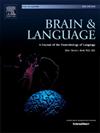食指作为美国手语语音结构的范畴知觉
IF 2.3
2区 心理学
Q1 AUDIOLOGY & SPEECH-LANGUAGE PATHOLOGY
引用次数: 0
摘要
在美国手语中,在手工字母表和/或数字系统中发现的特定手势(如食指指向数字“1”和食指弯曲的字母“x”)被认为在音系上是不同的,理由是手指的弯曲构成了音系上的独特特征。本研究调查了这一概念,建立在之前的美国手语的弯曲的分类知觉食指的行为研究。我们检查了180°和90°之间的不同程度的弯曲,使用的尺度从标准方言中的黑色和夏天的标志。实验1发现,当呈现各种程度的弯曲时,签名参与者识别出130°左右的分类边界。实验2利用脑电图研究了vMMN和P300对类别内和类别间古怪球的反应。据我们所知,这是第一次使用脑电图来研究美国手语的分类知觉。实验2的结果表明,手语参与者并不一致同意130°的边界,理由是“缺乏上下文”来识别手势。然而,一贯按照实验1中确定的边界对手势进行分类的手语参与者,其P300对类别间差异的反应强于对类别内差异的反应。然而,即使这些参与者在vMMN中也没有表现出CP效应。结合范畴边界所在位置的个体差异,这表明CP弯曲可能是美国手语中较弱的音位特征,而不是口语音位特征,或者可能是语音特征,而不是音位特征。本文章由计算机程序翻译,如有差异,请以英文原文为准。
Categorical perception of the index finger as an American Sign Language phonological construct
In American Sign Language, specific handshapes found in the manual alphabet and/or numbering system (such as the pointed index finger—the number “1”—and its bent counterpart—the letter “x”) are assumed to be phonologically distinct under the rationale that bentness of the finger(s) constitutes a phonemic distinctive feature. This study investigates this notion, building on previous behavioral studies of American Sign Language categorical perception of bentness of the index finger. We examined varying levels of bentness between 180° and 90° using a scale ranging from the signs BLACK and SUMMER in the standard dialect. Experiment 1 found that when presented with all levels of bentness, signing participants identified a categorical boundary around 130°. Experiment 2 used EEG to investigate vMMN and P300 responses to within-category and between-category oddballs. This is the first study to our knowledge to use EEG to investigates categorical perception in ASL. The results of Experiment 2 indicated that signing participants did not consistently agree on the 130° boundary, citing a “lack of context” to identify the sign. However, those signing participants who consistently categorized signs according to the boundary determined in Experiment 1 showed stronger P300 responses to between-category differences than to within-category differences. However, even these participants showed no CP effects in the vMMN. This, combined with individual variation in where the category boundary lies, suggests that CP bentness may be a weaker phonological feature in ASL than spoken phonemic features, or may instead be a phonetic, not phonological, feature.
求助全文
通过发布文献求助,成功后即可免费获取论文全文。
去求助
来源期刊

Brain and Language
医学-神经科学
CiteScore
4.50
自引率
8.00%
发文量
82
审稿时长
20.5 weeks
期刊介绍:
An interdisciplinary journal, Brain and Language publishes articles that elucidate the complex relationships among language, brain, and behavior. The journal covers the large variety of modern techniques in cognitive neuroscience, including functional and structural brain imaging, electrophysiology, cellular and molecular neurobiology, genetics, lesion-based approaches, and computational modeling. All articles must relate to human language and be relevant to the understanding of its neurobiological and neurocognitive bases. Published articles in the journal are expected to have significant theoretical novelty and/or practical implications, and use perspectives and methods from psychology, linguistics, and neuroscience along with brain data and brain measures.
 求助内容:
求助内容: 应助结果提醒方式:
应助结果提醒方式:


